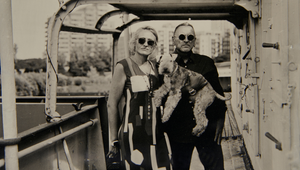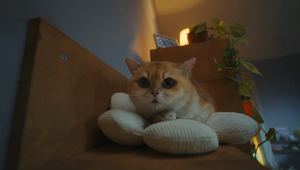
A.R.C’s Kirk Hendry on Storytelling Instincts and Debut Feature ‘Kensuke’s Kingdom’

Sitting down with Kirk Hendry, I got the sense that this was a filmmaker who breathes cinematic magic into every project he touches – no matter whether that’s a commercial, music video, short film, or, most recently, a triple British Animation Award-winning feature.
His big screen debut – ‘Kensuke’s Kingdom’, based on the novel by Sir Michael Morpurgo – was co-directed with Neil Boyle, and stars Cillian Murphy, Sally Hawkins, and Ken Watanabe. Its dreamy vistas have charmed international audiences, plunging them into the depths of its leafy island setting through a blend of classic, hand-drawn animation and modern 3D environments.
Above: Trailer for 'Kensuke's Kingdom'
Heavily stylised and stunning aesthetics abound in Kirk’s portfolio. His short film, ‘Junk’, tells a story of consumption in silhouettes, a computerised version of the style pioneered in the ‘20s by German filmmaker, Lotte Reiniger. Photoreal polar bears clumsily figure skate in his ‘Dancing on Ice’ commercials. But it’s Kirk’s live action work that got him his start in animation. Working with Argentinian magician El Mago Sérpico for XX Teens’ song ‘Round’, he used hand shadows to depict the circle of life in the jungle. That artistic visual style caught the attention of a London-based animation studio.

Above (clockwise from top left): Stills from XX Teens 'Round', Dancing on Ice, WWF 'Save the Cerrado', and 'Junk'
There, Kirk cut his teeth alongside Sylvain Chomet, the Oscar-nominated French director behind animation classics like ‘The Triplets of Belleville’. It's where he also met Ben Parkin and Alex Bedford, co-founders of A Running Commentary, which now represents him: "Kirk's work has always resonated with us on a personal level. His storytelling is heartfelt, by breathing life into well rounded characters, and always respects the audience's intellect. Every aspect of his films are painstakingly considered, and of course they are always beautifully cinematic. Cinema with a capital 'C'! We're excited to be exploring commercial projects with Kirk in addition to the development of future film projects."
Collaborating once again with El Mago Sérpico for World Wildlife Fund’s 'Save The Cerrado', Kirk now caught the eye of producer Sarah Radclyffe in her search for a director for ‘Kensuke’s Kingdom’. “She was going to make it live action,” Kirk recalls, “but she realised pretty quickly it was going to be very complicated to do with performing orangutans and children in the ocean. So then she had the idea of doing it animated.”
‘Kensuke’s Kingdom’ follows the adventure of Michael, a young boy who washes up on a remote island and must learn to protect its wildlife under the guidance of its only other human inhabitant – the mysterious Japanese World War II veteran, Kensuke. It’s an ecological theme that often crops up in Kirk’s portfolio. “Having lived in cities all my life, some part of my genetic memory rejects all this modernity and concrete and craves natural things.”

By the end of ‘Kensuke’s Kingdom’, the viewer, too, feels the urgent need for conservation, thanks to Kirk and his co-director Neil’s thorough characterisation of each animal species, from the orangutans right down to the insects. A bug is seen again and again caring painstakingly for her larvae; when the poachers arrive, she and her offspring are crushed underfoot, heartlessly wiped out in one stomp of a boot. “The experiment was, how do you make it so that when the poachers come to take these animals off the island, the audience feels like it's a violation, and it's actually a family being torn apart? When you set those things up and you pay them off later on, it's far more powerful emotionally.”
Dramatic yet subtle, Kirk and Neil convey such messages subliminally and wordlessly. “When we read the screenplay by Frank Cottrell-Boyce, we saw it as a silent film, essentially, which fits right into what we like to do.” Without paragraphs of exposition offering prime time for zoning out, Kirk explains, “you pull the audience in, because they have to work it out as they're watching.”

It’s what Kirk calls “cinematic storytelling” – making full use of visuals, editing, blocking, sound design, and especially music. “A lot of people think that movies are a visual medium, but I think the emotional weight comes 70% from the sound and music and 30% from the picture. If you mute the sound on a film, you often get cut off from it immediately. If you turn a picture off and listen to the sound and music, you're still pulled in emotionally.”

It’s a side to filmmaking that Kirk and Neil like to be heavily involved with, collaborating with composer Stuart Hancock on music and String and Tins’ Will Cohen on sound design in the case of ‘Kensuke’s Kingdom’. “We like that old school, ‘30s, Hollywood, narrative, romantic scoring that has a lot of leitmotifs. It's all subconscious storytelling. When Michael first washes up on the island and it’s being revealed through the mist, there's a lot of atonal music going on under there, but it's slowly introducing the notes in the chant Kensuke will be doing for the orangutans later on. So when you hear him singing, it's vaguely familiar.”
The absence of sound is just as important. “Even when there's no music, particularly when you drop the sound out entirely, that's still a musical decision, like when the ink drop comes off the brush in the Nagasaki sequence. It’s very effective for making the audience hold their breath at that moment.” It’s the same with visuals: all the death happens off screen. “That wasn't because we were trying to clean it up for children; it's just more dramatic to do that. If you set up an idea that something awful is going to happen, what you imagine in your mind is always far worse than what you can show. Sometimes, if you show horrible things like guts everywhere, it can look a bit comical. It's more dramatically impactful to someone to have it happen off screen.”

Practically every detail of the film has been carefully considered, and Kirk and Neil’s efforts have paid off: its first screening brought its most important critic – Sir Michael himself – to happy tears. “He said it's his favourite adaptation, and that now, when he thinks of ‘Kensuke’s Kingdom’, he doesn't think of his book, but of this film. So that's the ultimate tribute.”
At the end of the day, however, it’s when satisfying their own desires as viewers that magic is made. “The films we really appreciated growing up were the ones that didn't talk down to the audience. So when it became our turn to make movies, we wanted to do the same thing for young people and adults. We're just making what we want to see, and there's some universality in that.”
















